The Austro-Hungarian secret weapon
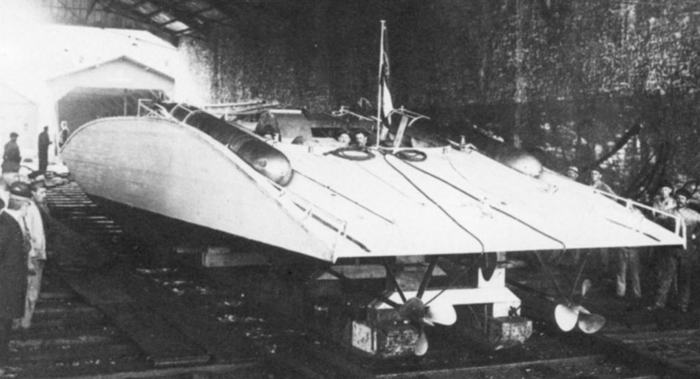
The Versuchsgleitboot (“Above, gliding boat”) was a prototype of a fast, small wing-in-ground torpedo boat build in 1916 by Dagobert Müller von Thomamuehl. It was out of this world at that time, by using a particular hover effect to lift it just above the surface, reaching a top speed of 32,6 knots. The craft was also impervious to mines and can fly above harbour defense nets also. Unfortunately, guidance proved problematic and the engine failed to show sufficient reliability. As a result, the hybrid craft, in between a plane and a boat, was never ordered in serie.
A revolutionary wing-in-ground effect military craft
The Wing-in-Ground effect has been already detailed in a post on a much more modern craft, the Soviet Ekranoplane, the A90 Orlyonok. The effect was known by early pilots, which planes were very light and when landing, even at low speed, tended have so much lift they “refused to land” when almost making a touchdown. That effect was later theorised and better known through mathematics and experimentations all along the interwar. Also, the first mention of the concepts of surface-effect crafts termed “hovering” was coined by Swedish scientist Emanuel Swedenborg in 1716. In the next century, shipbuilder Sir John Isaac Thornycroft patented an early design. This was for an air cushion ship or “hovercraft” in the 1870s. It was however undoable since compact and powerful engines had to wait for the early XXth century. In 1877 Thornycroft patented a hollow-bottomed air cushion boat filled with compressed air. He was followed by Swedish engineer Hans Dineson design, which invented flexible rubber cushion seals.
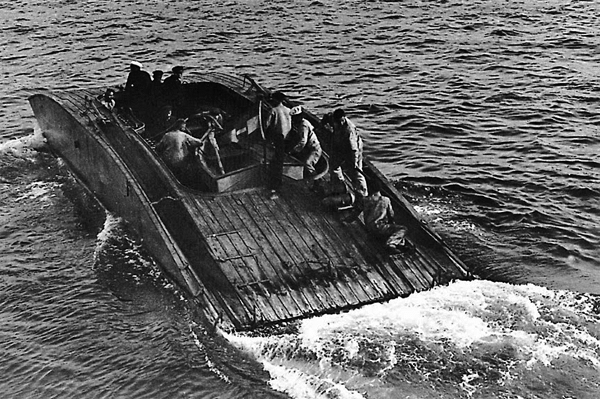
Unlike hovercrafts, the Versuchsgleitboot looked like a wing with rigid ‘skirts’ on the sides to trap air, but not on the entry or exit of the wing/hull profile so to trap the air. There was an engine to create an air cushion, located towards the front. It was capable of lifting the rear section up to 10 inches over the surface. Passed 20 knots, the craft was completely off the water. The Gleitboote was an “air cushion” boat (Luftkissengleitboot).
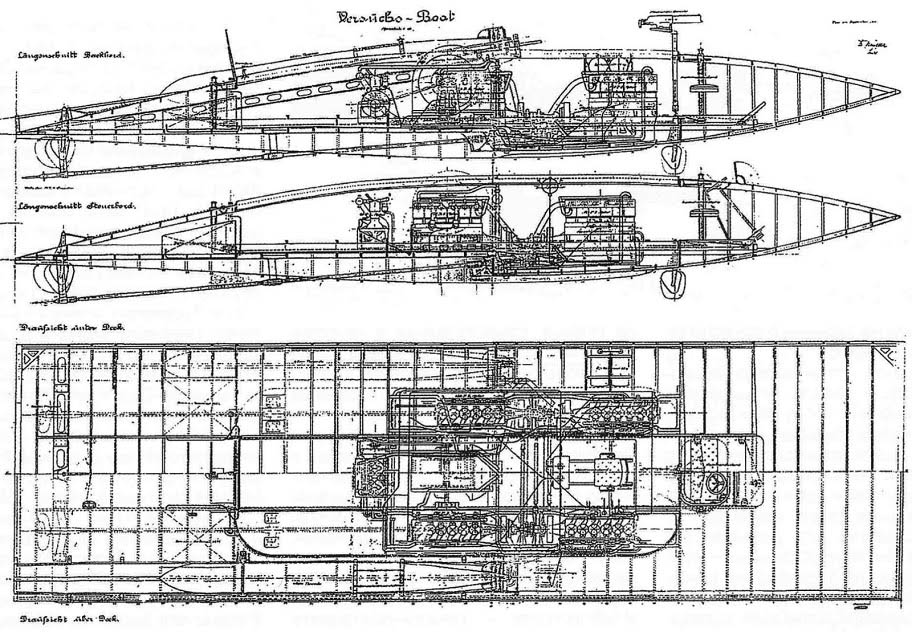
About Dagobert Müller Von Thomamuel
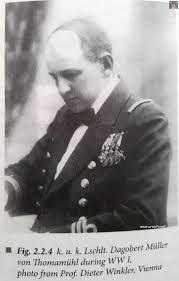 Lieutenant Commander Müller von Thomamühl was an inventive and dashing naval officer who displayed personal courage and enterprise and his life was very much connected to the sea and Croatia, Bohemia and old Austria. Like many other Austro-Hungarian seafarers, he also improved on existing technology. However his personal story was also connected to the tragedy of of the old Monarchy and successor states.
Lieutenant Commander Müller von Thomamühl was an inventive and dashing naval officer who displayed personal courage and enterprise and his life was very much connected to the sea and Croatia, Bohemia and old Austria. Like many other Austro-Hungarian seafarers, he also improved on existing technology. However his personal story was also connected to the tragedy of of the old Monarchy and successor states.
Born in Trieste in 1880, Müller in 1900 circumnavigated on the sailing training ship “Danube” and participated in the Expeditionary Corps against the Boxer Rebellion in China, was later on a mission trip to safeguard trade interests in Africa and South America, learned about torpedoes, became a Lieutenant on a liner, commanded various torpedo boats, was awarded for bravery, became first commander of the diving school in Pola, developed a diving device with which he reached 64 m, a world record at the time. He collaborated with Prof. dr. Stiegler in the study of the effects of weightlessness and pressure conditions underwater on humans. He discovered first hand the toxic effects of nitric oxide and made the first tables on diving times to avoid diving disease. He also was a driving force into making a pressure chamber to alleviate their consequences.
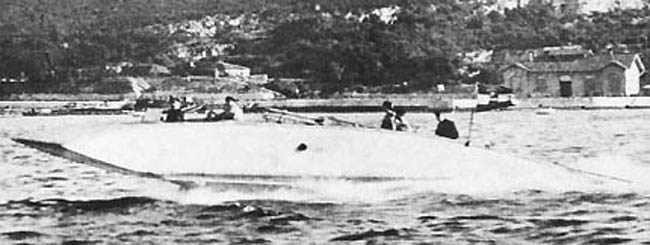
In 1915 -1916 he had this idea of a light torpedo boat that could use a new mode of sustentation, to be faster, and started working on a wooden air-cushion gliding boat in Pola. This “hovercraft” was inspired by the conviction that the torpedo, the most advanced and advanced weapon of its time, needed to be served by a boat with greater necessary agility and speed, in order to give an edge to the small Austrian navy.
His idea was to combine the new principle of the English motor launch with the air cushion principle.
After the first speed tests were reported to Vienna, he moved to Dubrovnik but to his return, found his boat disassembled to the last rivet, even the engines, by Viennese engineers. He saw this an act of services rivalry, adverse academics and the bureaucracy. (See later for the development of the Gleitboote).
Afterwards in 1917, Müller Von T. initiated the first Austro-Hungarian aircraft torpedo with Rtr Gottfried v. Banfield, and participated in an attack on the Otranto barrage. As a torpedo expert, he created the torpedo command and took its head in 1918 with the grade of Korvettenkapitän and owner of the Navy Merit Cross. After the fall of the Monarchy he became a Czech citizen. He is credited woth the invention of the photoelectric barrier with Prof. Hans Thirring, with one example installed in Kherson. Rights were bought by Carl Zeiss and later by Siemens-Halske. He would later work as a commercial in Yugoslavia for marine hardware, between Germany and UK. He became (forced) German in 1938 with the annexation and later fled impoverished with his family to Klagenfurt, not far away from the sea, navy and Croatia. He passed away in 1956, buried in Pola.
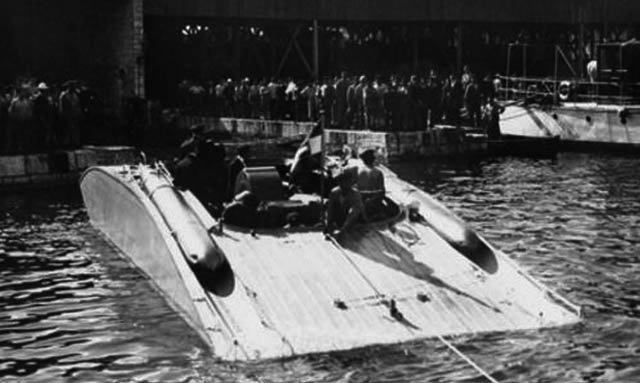
Development of the Gleitboote
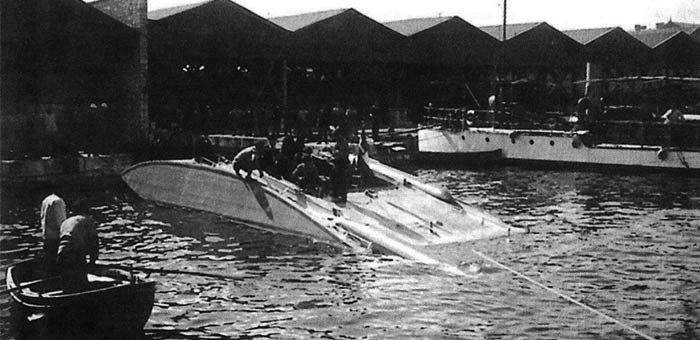
Ideas for this craft came for small scale experimentation, and theoretical essays about the effect, as a solution to avoid drag. There were already experimentations in a close field since 1898, by Italian inventor Enrico Forlanini which started experimenting with hydrofoils using a “ladder” foil system. In 1901, also, British boat designer John Thornycroft worked on stepped hull models with a single bow foil translated in 1909 with the 22-foot (6.7 m) Miranda III. The next Miranda IV was credited for reaching a very honorable 35 kn (65 km/h; 40 mph) with a fraction of the power of any torpedo boat of the time.
From 1906 in the USA many patents and vulgarization made the concept popular and Alexander Graham Bell started work on an advanced hydrofoil boat with his chief engineer Casey Baldwin. They also went to work with Forlanini in Italy, and at his Beinn Bhreagh estate near Baddeck, Nova Scotia, Belle experimented with various designs, ending with the Bell HD-4, capable of 47 knots, just before the end of the war, with Renault engines. After obtaining more powerful 260 kW (350 hp) engines he devised in 1918 the HD-4, which will set a world marine speed record at 62 knots (71 mph), still valid in 1939. So these works were very much known to Dagobert.
Thomamühl began his experiments with a high-speed glide-boat using the ground effect by air cushion, but this “trial glider” was already designed from the outset as a torpedo carrier.
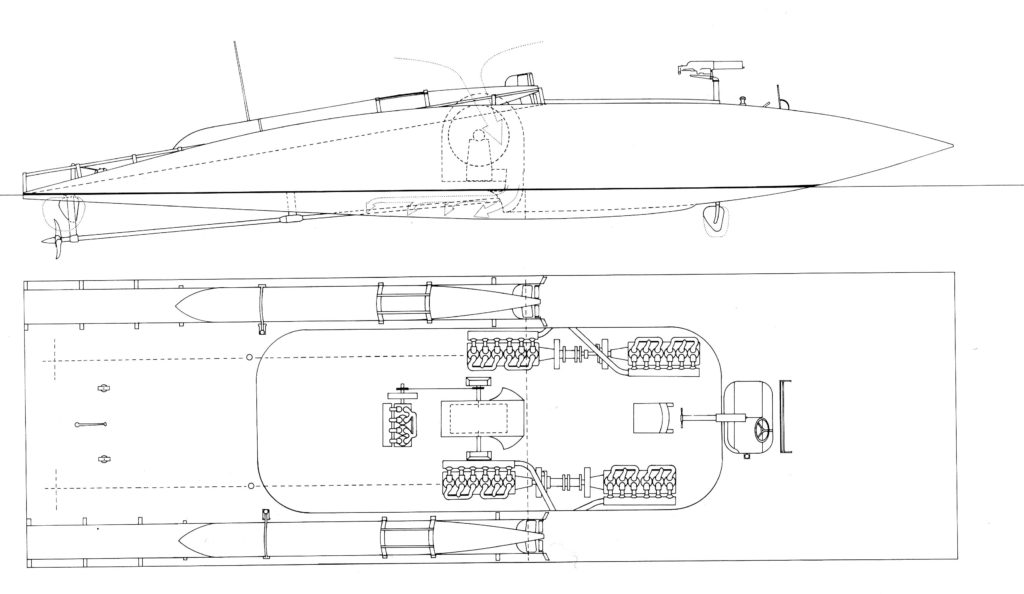
Using non-strategic materials (wood) as a safe working basis, Dagobert drawn a kind of “floating wing”, shaped like a section of a large aerofoil. This had the natural advantage to create a low pressure area above like an aircraft. For propulsion he needed compact engines and naturally turned towards aero engines. Four were needed to drive two submerged marine propellers. This was not sufficient however as the large rectangular shape would have create a lot of drag and needed a fifth engine in order to create the lift. The wooden structure was made of braced sections and was both solid and light.
This fifth engine was linked via a transmission chain to the propeller, placed vertically in a cylindrical chamber, blewing air below, directed into a “chamber” only partially enclosed by the sides of the craft. The goal was this air blown to the front of the craft increased air pressure under it. When in motion, the air was trapped under the front, the pressure raised and this also increased lift. Therefore the Gleitboot could not be compared to a hovercraft, as it always needed water below, and could not transition to land or other surfaces.
Also, given Dagobert’s involvement with the torpedo boats in the Navy, designed this as a fast torpedo boat, with a top speed over 32 knots (59 km/h). Basically this “floating wing” had a large central opening with the operators, and a smaller opening further forward in which was located the helmsman, steering and instrumentation. The flanks bridge was large enough to walk from the long forward and aft decked “beaches”, but the crew avoided walking in these areas when at speed to avoid unbalancing the craft. The interior opening where the crew stood, was already crowded with four engines and the central cylinder containing the propeller creating the air suppression below.
The torpedoes were located in cradles either side of the hull with their steering at the level of the central compartment so they can be launched manually by the crew. They were dropped head first like most torpedo crafts of the time. For close defense two pintle-mounted Schwartzlöse liquid-cooled machine guns were placed on the corners of the central opening so to be used against sea and airborne targets. Both torpedoes were 450 mm models, the same carried by standard Austrian torpedo-boats.
Later in the interwar, 1926-27, theoretical grounds for motion over an air layer were formulated and calculated by Konstantin Eduardovich Tsiolkovskii, father of the Russian astrophysics.
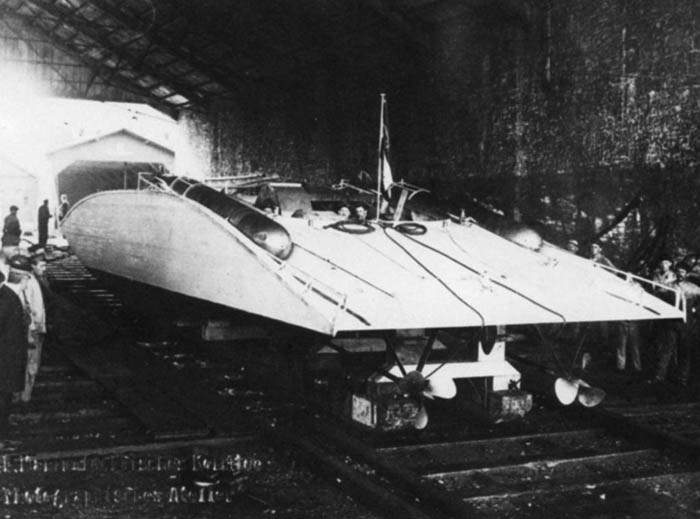
Rejection by the navy
The Versuchgleitboot was abundantly tested and when judged ready, armed with torpedoes and a Schwartlose machine gun. However she would never see actual combat. It is known the craft proceeded to at least 2-3 torpedo launches to assess its qualities as delivery platform.
Reviewing military authority board found many issues with the Versuchsgleitboot. Officially, it was unstable in high seas, not particularly a good platform for launching torpedoes or depth charges, which limited its military effectiveness. In the end the board did not recommend further development (Torpedo planes were seen as a more promising development). After being scrapped, the engines (according to another source) were returned to the aviation.
Sources are conflicting over this design not being a true hovercraft, which would be the 1959 Saunders-Roe model, but it was certainly the first “surface effect” propelled vehicle.
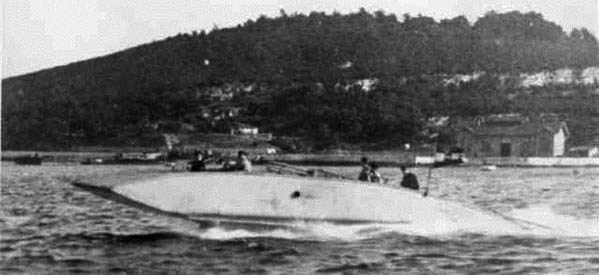
We can only guess what would happen if the craft was given a different shape and more powerful engines, deriving into a true “ekranoplane” like their cold war Russian derivatives. The war was approaching fast, but if carried by, for example, a fast cruiser with the stern and aft deck rebuilt to carry a serie of such crafts (eight for example), could have “released” a squadron to attack the harbor of Otranto where military vessels were stationed, and dealt quite a blow to the entente. Indeed, ports were generally impassable to torpedo boats since the days of Port Arthur and the Japanese surprise attack: Nets were placed across the entrance for example and mines.
Pola was not exception to this and probably the best protected. That’s why the Italians devised the “Grillo“, to attack Pola, by climbing over obstacle. In a similar way, the Austro-Hungarians planned to “surf” over them. This was probably the way forward and indeed the Soviet Navy and the Italians would explore this new path in the 1970s. Today, 100 years after, the wing-in-ground effect is well understood and there are promising development away. That’s make Thomamhül a true pioneer, worthy to be remembered today.
Reconstruction project
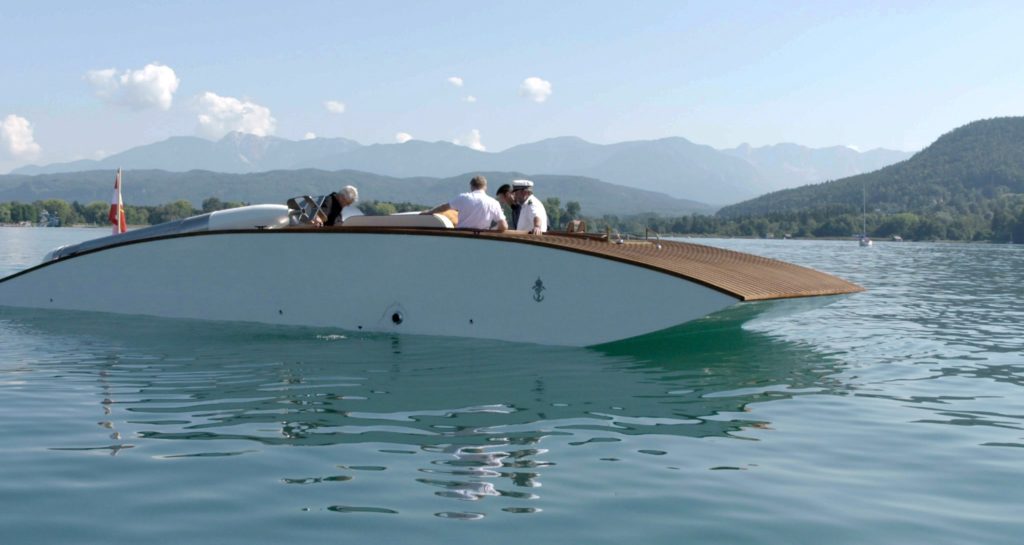
The Modern reconstruction, which was completed by 2015, for the centennial of the invention.
The reconstruction project started with Walter Krobath in Klagenfurt in 2012. The project was soon labelled as a company called “leadership” due to the innovative nature of the boat. The replica was inaugurated in the summer 2015, with the official naming and launching ceremony.
The new craft is 13m in length, 4m in width, 1.80m in height which was as close as the original as possible, and built from larch wood, suitable for the high seas. The deck is clad with teak frames.
The powerplant of course is brand new but equivalent (if largely superior) in power to the original, two high-performance STEYER marine engines, driving two propellers for a total of 560 hp and a third engine, 160 hp placed on the bottom to provide the air cushion effect.
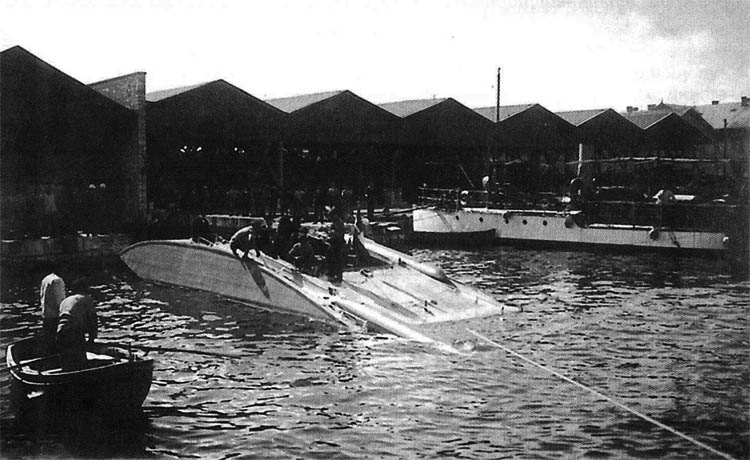
V. specifications |
|
| Dimensions | 13 x 5 x 4 m |
| Displacement | 6.5 tonnes unloaded |
| Crew | 5 |
| Propulsion | 2 shafts 4 120PS aero engines + 1 air compressor 65PS aero engine 450 m3/min |
| Speed | 35 knots (40 knots theoretical) |
| Armament | 2 450 mm torpedoes, 3-6 ASW grenades, Schwarzlose machine gun | Armor | None |
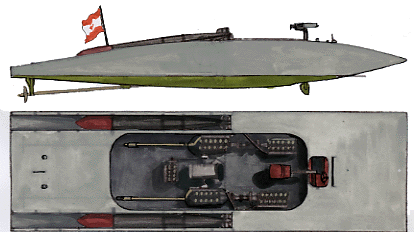
Author’s summary rendition
Links and sources
Conway’s all the workds fighting ship 1906-21 (mention and a few lines)
//www.visionaer.info/leadership/erfinder.htm
//forum.worldofwarships.eu/topic/3625-kuk-versuchsgleitboot-first-ever-build-hovercraft/
//en.wikipedia.org/wiki/Surface_effect_ship
//eugen-savoyen.livejournal.com/20776.html
//www.doppeladler.com/kuk/gleitboot.htm
//austria-forum.org/af/Biographien/M%C3%BCller-Thomam%C3%BChl%2C_Dagobert
//www.pss.at/text.php?id=244
//www.brighthubengineering.com/naval-architecture/97238-the-first-hovercraft/
//www.navypedia.org/ships/austrohungary/ah_cf_vgb.htm
//www.hovercraft.pl/versuchsgleitboot
//www.paluba.info/smf/index.php?topic=13303.0
//gcaptain.com/maritime-monday-june-third-twntythrtn-hovercraft/
//geschimagazin.wordpress.com/2011/06/19/das-luftkissenfahrzeug-des-k-u-k-leutnants-mueller-von-thomamuehl/
//www.wundertec.at/projekte/kk-luftkissenboot/
//www.brighthubengineering.com/naval-architecture/97238-the-first-hovercraft/


 Latest Facebook Entry -
Latest Facebook Entry -  X(Tweeter) Naval Encyclopedia's deck archive
X(Tweeter) Naval Encyclopedia's deck archive Instagram (@navalencyc)
Instagram (@navalencyc)





 French Navy
French Navy Royal Navy
Royal Navy Russian Navy
Russian Navy Armada Espanola
Armada Espanola Austrian Navy
Austrian Navy K.u.K. Kriegsmarine
K.u.K. Kriegsmarine Dansk Marine
Dansk Marine Nautiko Hellenon
Nautiko Hellenon Koninklije Marine 1870
Koninklije Marine 1870 Marinha do Brasil
Marinha do Brasil Osmanlı Donanması
Osmanlı Donanması Marina Do Peru
Marina Do Peru Marinha do Portugal
Marinha do Portugal Regia Marina 1870
Regia Marina 1870 Nihhon Kaigun 1870
Nihhon Kaigun 1870 Preußische Marine 1870
Preußische Marine 1870 Russkiy Flot 1870
Russkiy Flot 1870 Svenska marinen
Svenska marinen Søværnet
Søværnet Union Navy
Union Navy Confederate Navy
Confederate Navy Armada de Argentina
Armada de Argentina Imperial Chinese Navy
Imperial Chinese Navy Marinha do Portugal
Marinha do Portugal Mexico
Mexico Kaiserliche Marine
Kaiserliche Marine 1898 US Navy
1898 US Navy Sovietskiy Flot
Sovietskiy Flot Royal Canadian Navy
Royal Canadian Navy Royal Australian Navy
Royal Australian Navy RNZN Fleet
RNZN Fleet Chinese Navy 1937
Chinese Navy 1937 Kriegsmarine
Kriegsmarine Chilean Navy
Chilean Navy Danish Navy
Danish Navy Finnish Navy
Finnish Navy Hellenic Navy
Hellenic Navy Polish Navy
Polish Navy Romanian Navy
Romanian Navy Turkish Navy
Turkish Navy Royal Yugoslav Navy
Royal Yugoslav Navy Royal Thai Navy
Royal Thai Navy Minor Navies
Minor Navies Albania
Albania Austria
Austria Belgium
Belgium Columbia
Columbia Costa Rica
Costa Rica Cuba
Cuba Czechoslovakia
Czechoslovakia Dominican Republic
Dominican Republic Haiti
Haiti Hungary
Hungary Honduras
Honduras Estonia
Estonia Iceland
Iceland Eire
Eire Equador
Equador Iran
Iran Iraq
Iraq Latvia
Latvia Liberia
Liberia Lithuania
Lithuania Mandchukuo
Mandchukuo Morocco
Morocco Nicaragua
Nicaragua Persia
Persia San Salvador
San Salvador Sarawak
Sarawak Uruguay
Uruguay Venezuela
Venezuela Zanzibar
Zanzibar Warsaw Pact Navies
Warsaw Pact Navies Bulgaria
Bulgaria Hungary
Hungary

 Bundesmarine
Bundesmarine Dutch Navy
Dutch Navy Hellenic Navy
Hellenic Navy Marina Militare
Marina Militare Yugoslav Navy
Yugoslav Navy Chinese Navy
Chinese Navy Indian Navy
Indian Navy Indonesian Navy
Indonesian Navy JMSDF
JMSDF North Korean Navy
North Korean Navy Pakistani Navy
Pakistani Navy Philippines Navy
Philippines Navy ROKN
ROKN Rep. of Singapore Navy
Rep. of Singapore Navy Taiwanese Navy
Taiwanese Navy IDF Navy
IDF Navy Saudi Navy
Saudi Navy Royal New Zealand Navy
Royal New Zealand Navy Egyptian Navy
Egyptian Navy South African Navy
South African Navy






























 Ukrainian Navy
Ukrainian Navy dbodesign
dbodesign